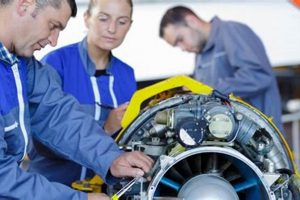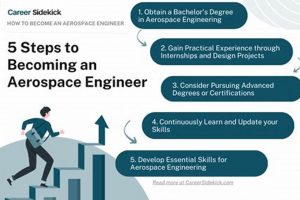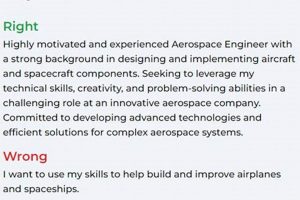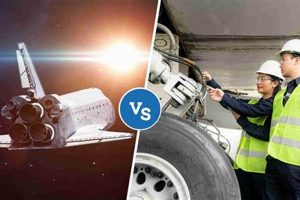An aerospace engineering degree equips individuals with a robust understanding of the principles governing the design, development, and testing of aircraft and spacecraft. Graduates possess expertise in aerodynamics, propulsion, materials science, structural analysis, and control systems. This knowledge base allows them to tackle complex engineering challenges related to flight and space exploration. For example, a graduate may contribute to the design of more fuel-efficient aircraft wings or develop advanced guidance systems for satellites.
The value of this specialized education lies in its contribution to technological advancement, national security, and economic growth. Historically, aerospace engineers have been instrumental in pushing the boundaries of what is possible in flight, from the first powered airplanes to the development of spacefaring technology. The skills acquired are applicable not only within the aerospace sector but also in other industries demanding sophisticated engineering solutions. This leads to significant career flexibility and opportunities for impactful contributions.
The following sections will detail specific career paths, required skills, potential earning expectations, and further educational opportunities that individuals with this academic background can pursue. The breadth of application makes understanding these options essential for students considering or possessing this qualification.
Career Guidance for Aerospace Engineering Graduates
This section provides practical advice for individuals considering or holding a degree in aerospace engineering, focusing on maximizing career potential and making informed decisions.
Tip 1: Develop a Strong Foundation in Core Subjects: A thorough understanding of mathematics, physics, and computer science is crucial. These subjects underpin all aspects of aerospace engineering. Proficiency in these areas facilitates problem-solving and innovation in complex engineering scenarios. For example, mastering computational fluid dynamics allows for efficient analysis of aerodynamic performance.
Tip 2: Gain Practical Experience Through Internships: Internships offer invaluable exposure to real-world engineering challenges. Participating in internships at aerospace companies, research institutions, or government agencies provides opportunities to apply theoretical knowledge and develop practical skills. This experience can significantly enhance a graduate’s competitiveness in the job market.
Tip 3: Specialize in a Specific Area of Interest: Aerospace engineering encompasses diverse specializations, such as aerodynamics, propulsion, structures, and avionics. Focusing on a specific area allows for in-depth expertise and positions graduates for specialized roles. This focused expertise can lead to advanced research opportunities or specialized positions within the industry.
Tip 4: Cultivate Strong Communication Skills: Effective communication is essential for collaborating with multidisciplinary teams, presenting technical findings, and writing technical reports. Developing strong written and verbal communication skills is vital for professional success. Participating in technical presentations or writing research papers enhances these capabilities.
Tip 5: Network with Professionals in the Field: Attending industry conferences, joining professional organizations (e.g., AIAA), and connecting with aerospace engineers can provide valuable insights, mentorship opportunities, and potential job leads. Networking expands professional horizons and facilitates career advancement.
Tip 6: Consider Advanced Education: Pursuing a master’s or doctoral degree can enhance specialization and research capabilities. Advanced degrees are often required for research and development roles and can lead to higher earning potential. A graduate degree can open doors to leadership positions and specialized research opportunities.
These guidelines are intended to assist individuals in navigating the various opportunities available and maximizing the impact of their education. By focusing on core skills, practical experience, and continuous learning, graduates can position themselves for fulfilling and impactful careers.
The following section will address potential challenges and strategies for overcoming them in the pursuit of an aerospace engineering career.
1. Aircraft Design
Aircraft design represents a core application for individuals possessing an aerospace engineering degree. The degree provides the foundational knowledge of aerodynamics, structural mechanics, materials science, and control systems necessary to conceptualize, analyze, and optimize aircraft performance. The ability to apply these principles directly impacts the efficiency, safety, and environmental impact of air transportation. For example, an aerospace engineer working in aircraft design might use computational fluid dynamics simulations to refine wing shapes, reducing drag and improving fuel efficiency, a direct contribution to lowering carbon emissions from aviation. The design process necessitates a deep understanding of regulatory requirements, safety standards, and manufacturing processes, further highlighting the degree’s practicality.
Beyond the theoretical aspects, practical application involves using CAD/CAM software for creating detailed designs, conducting wind tunnel tests for validation, and collaborating with manufacturing teams to ensure design feasibility. The rise of electric and hybrid-electric propulsion systems has introduced new challenges and opportunities within aircraft design, requiring engineers to integrate novel technologies and optimize energy storage and management systems. Furthermore, the increasing demand for unmanned aerial vehicles (UAVs) or drones has created a surge in opportunities for aerospace engineers specialized in aircraft design, demanding expertise in areas like autonomous flight control and payload integration.
Consequently, a strong foundation in aircraft design provides a launchpad for diverse career paths within the aerospace industry, ranging from research and development to manufacturing and testing. Addressing the challenges of future air transportation, such as reducing noise pollution and developing sustainable aviation fuels, relies heavily on the expertise of aerospace engineers specializing in aircraft design. The practical significance lies in the constant need to improve existing aircraft and develop innovative designs that can meet evolving societal and environmental needs, ensuring the continued evolution of air travel.
2. Spacecraft Engineering
Spacecraft engineering, a specialized domain within aerospace engineering, represents a significant application of the knowledge and skills acquired through the degree. This area encompasses the design, development, testing, and operation of vehicles and systems designed to function in the extreme environments of space. Individuals with an aerospace engineering background are well-suited for roles in this technologically demanding sector.
- Orbital Mechanics and Trajectory Design
Orbital mechanics, a cornerstone of spacecraft engineering, dictates the movement of spacecraft in response to gravitational forces. Trajectory design utilizes these principles to plan missions efficiently, considering fuel consumption, transit time, and mission objectives. For instance, engineers apply Hohmann transfer orbits to move spacecraft between different altitudes, optimizing fuel use. Understanding and applying these concepts is fundamental for any role related to spacecraft navigation and mission planning.
- Spacecraft Subsystems Design
Spacecraft are complex systems composed of interconnected subsystems, including power, thermal control, communication, and attitude control. Power systems, often relying on solar arrays or radioisotope thermoelectric generators (RTGs), provide energy for onboard operations. Thermal control systems maintain a suitable temperature range for sensitive electronics. Communication systems facilitate data exchange with Earth. Attitude control systems orient the spacecraft in space. Expertise in one or more of these subsystems is a common career path.
- Materials and Structures for Space Environments
Spacecraft operate in harsh environments characterized by extreme temperatures, vacuum conditions, and radiation exposure. Selecting materials capable of withstanding these conditions is critical to mission success. Materials such as composites, aluminum alloys, and specialized polymers are commonly employed. Engineers must also design structures capable of withstanding launch loads and micrometeoroid impacts. This specialized knowledge allows for the development of durable and reliable spacecraft components.
- Testing and Validation
Given the cost and complexity of space missions, rigorous testing and validation are essential. Spacecraft components and entire systems undergo extensive testing in simulated space environments, including thermal vacuum chambers and vibration test facilities. This process ensures that the spacecraft will perform as expected in orbit. Aerospace engineers play a vital role in designing and executing these tests, as well as analyzing the results to identify and correct any potential issues.
These facets of spacecraft engineering, deeply rooted in the core principles of aerospace engineering, demonstrate the diverse career options available. Designing communication systems, modelling orbital paths, or assessing the structural integrity of components offer challenging and rewarding applications of knowledge acquired from such a degree.
3. Propulsion Systems
The design, development, and analysis of propulsion systems constitute a critical pathway for individuals with an aerospace engineering degree. These systems, which generate the thrust necessary for aircraft and spacecraft to overcome gravity and atmospheric resistance, are fundamental to the functionality of these vehicles. A comprehensive understanding of thermodynamics, fluid mechanics, and combustion is essential for creating efficient and reliable propulsion technologies. For example, a graduate with expertise in propulsion might contribute to the development of a more fuel-efficient turbofan engine for commercial aircraft or to the design of a rocket engine for space launch vehicles. The performance characteristics of propulsion systems directly dictate the range, speed, and payload capacity of aerospace vehicles, therefore propulsion advancements directly impact the success of aerospace missions.
Practical application of propulsion principles extends beyond theoretical analysis. It encompasses the creation of detailed designs using CAD software, the execution of engine tests in specialized facilities, and the analysis of experimental data to validate performance models. The field is increasingly focused on the development of sustainable propulsion technologies, such as electric propulsion for satellites, hybrid-electric propulsion for aircraft, and advanced chemical propellants with lower environmental impact. The development of scramjet engines for hypersonic flight also presents a significant challenge and opportunity for propulsion engineers. These advancements require not only deep knowledge of engineering principles but also the ability to work in multidisciplinary teams and adapt to emerging technologies.
In summary, propulsion systems represent a cornerstone of aerospace engineering, providing a direct link between theoretical knowledge and practical application. Addressing challenges related to efficiency, sustainability, and performance in extreme environments relies heavily on the expertise of aerospace engineers specializing in propulsion. Understanding the fundamental principles and embracing innovative technologies is crucial for driving progress in this field and ensuring the continued advancement of aerospace capabilities. Therefore expertise in propulsion is indispensable with an aerospace engineering degree.
4. Avionics Integration
Avionics integration constitutes a critical application for individuals with an aerospace engineering degree. It involves the complex process of combining various electronic systems to ensure the proper functioning and control of aircraft and spacecraft. This domain merges electrical engineering, computer science, and aerospace principles, presenting a challenging and rewarding career path.
- Flight Control Systems
Flight control systems are a central component of avionics integration, governing the aircraft’s movement and stability. These systems utilize sensors, actuators, and computer algorithms to maintain desired flight parameters. An aerospace engineer involved in this area might design and implement control laws to improve aircraft handling characteristics or develop fault-tolerant systems to ensure safe operation in the event of component failure. The integration requires a deep understanding of aerodynamics and control theory.
- Navigation and Guidance Systems
Navigation and guidance systems provide accurate positioning and directional information for aircraft and spacecraft. These systems rely on GPS, inertial measurement units (IMUs), and radar altimeters to determine location and attitude. Aerospace engineers in this field develop algorithms for sensor fusion, error correction, and trajectory optimization. This expertise is essential for both manned and unmanned aerospace vehicles.
- Communication and Data Systems
Communication and data systems facilitate the exchange of information between the aircraft or spacecraft and ground control stations. These systems handle voice communication, telemetry data, and command signals. Aerospace engineers working in this area design and implement communication protocols, data encryption methods, and antenna systems. The integration requires an understanding of radio frequency (RF) engineering and network protocols.
- Display and Human-Machine Interface (HMI)
Display and HMI systems present critical flight information to the pilot or operator, enabling them to make informed decisions. These systems include cockpit displays, head-up displays (HUDs), and control panels. Aerospace engineers involved in this area design and implement user interfaces, develop data visualization techniques, and conduct human factors studies to optimize the effectiveness and usability of the system. This integration draws on expertise in computer graphics and cognitive psychology.
These facets of avionics integration demonstrate the diverse opportunities available to those holding an aerospace engineering degree. They showcase the skills needed to bridge the gap between hardware and software, thus delivering superior functionality for aerospace vehicles. These aspects also require a multidisciplinary approach, and showcase the practical application of theoretical concepts.
5. Research & Development
Research and development (R&D) constitutes a prominent and vital career trajectory for individuals possessing an aerospace engineering degree. R&D roles focus on the advancement of aerospace technologies and the creation of innovative solutions to complex engineering challenges. The work encompasses a broad spectrum of activities, from fundamental scientific investigation to the development and testing of prototype systems. The relevance lies in driving progress within the aerospace sector, enhancing performance, improving safety, and reducing environmental impact. The following aspects elaborate on the role R&D plays in aerospace engineering.
- Aerodynamics Research
Aerodynamics research focuses on understanding and manipulating airflow around aerospace vehicles to optimize performance and efficiency. This includes developing advanced wing designs, studying boundary layer effects, and exploring novel control surfaces. For example, researchers are investigating active flow control techniques to reduce drag and improve lift characteristics. Expertise in aerodynamics is crucial for designing more fuel-efficient aircraft and high-performance spacecraft.
- Propulsion Systems Research
Propulsion systems research aims to develop more efficient, powerful, and environmentally friendly propulsion technologies. This encompasses research into advanced rocket engines, electric propulsion systems, and alternative jet fuels. For instance, researchers are exploring the use of scramjet engines for hypersonic flight and developing electric propulsion systems for deep-space missions. Advances in propulsion technology enable longer-range missions and reduce the environmental footprint of air travel.
- Materials and Structures Research
Materials and structures research focuses on developing lightweight, high-strength materials and innovative structural designs for aerospace vehicles. This includes research into composite materials, nanomaterials, and additive manufacturing techniques. For example, researchers are investigating the use of carbon fiber composites to reduce aircraft weight and developing self-healing materials for spacecraft structures. Advances in materials and structures improve vehicle performance, enhance durability, and reduce manufacturing costs.
- Avionics and Control Systems Research
Avionics and control systems research focuses on developing advanced electronic systems and control algorithms for aerospace vehicles. This includes research into autonomous flight control, sensor fusion, and artificial intelligence. For example, researchers are developing autonomous navigation systems for unmanned aerial vehicles (UAVs) and exploring the use of AI to improve aircraft safety. Advances in avionics and control systems enable more efficient operation, enhance safety, and reduce pilot workload.
These research areas represent only a portion of the opportunities available to individuals with an aerospace engineering degree. Participation in R&D enables engineers to contribute to the forefront of technological advancement, shaping the future of aerospace. The skills and knowledge gained through R&D are highly valued in both industry and academia, leading to diverse career paths in design, manufacturing, and research institutions. This shows that “what can i do with a degree in aerospace engineering” leads to innovative and important R&D career paths.
6. Project Management
An aerospace engineering degree provides a strong foundation for project management roles within the aerospace sector. The rigorous curriculum instills analytical and problem-solving skills essential for planning, executing, and monitoring complex engineering projects. Furthermore, the technical understanding gained enables effective communication and collaboration with engineers, scientists, and other stakeholders. The connection between the degree and project management lies in the inherent requirement for structured management to bring aerospace endeavors to fruition, considering budgetary, scheduling, and performance constraints. Real-life examples encompass managing the development of new aircraft components, overseeing satellite launches, or coordinating the design and construction of wind tunnels. The practical significance of this understanding is improved project outcomes, reduced risk, and efficient resource utilization.
Successful aerospace project managers often leverage their technical background to make informed decisions, anticipate potential challenges, and effectively resolve technical issues. For instance, a project manager with a strong understanding of aerodynamics can better assess the feasibility of design changes and mitigate risks associated with aerodynamic performance. Similarly, familiarity with materials science allows for informed selection of materials and manufacturing processes. A specific example is managing the development of a new commercial aircraft wing. The project manager, drawing on their aerospace engineering knowledge, can effectively coordinate the activities of design engineers, structural analysts, manufacturing specialists, and test pilots, ensuring the wing meets performance, safety, and regulatory requirements. Furthermore, this background can be used to implement new methods in a practical fashion.
In conclusion, possessing both an aerospace engineering degree and project management skills creates a valuable combination. The technical expertise informs decision-making and facilitates effective collaboration, while project management principles ensure projects are completed on time, within budget, and to the required specifications. Addressing the increasingly complex nature of aerospace projects necessitates individuals capable of bridging the gap between engineering and management, making this a crucial pathway in “what can i do with a degree in aerospace engineering”.
7. Consulting Roles
Consulting roles represent a significant application of an aerospace engineering degree, leveraging the specialized knowledge and analytical skills acquired during academic training. These roles involve providing expert advice and solutions to organizations facing technical challenges within the aerospace sector. Aerospace engineers in consulting apply their expertise in areas such as aerodynamics, propulsion, structural analysis, and systems engineering to assist clients in optimizing designs, improving operational efficiency, and ensuring regulatory compliance. A common scenario involves a consulting engineer assessing the aerodynamic performance of a proposed aircraft design for a manufacturing company, identifying potential areas for improvement, and recommending design modifications to enhance fuel efficiency or reduce drag. The importance of consulting stems from its capacity to offer objective, data-driven insights that can significantly impact project outcomes and business strategies.
The application of an aerospace engineering background in consulting extends beyond technical analysis. Consultants also provide guidance on regulatory compliance, risk management, and technology integration. For example, a consultant may assist an airline in implementing new safety protocols or conduct a risk assessment of a space launch operation. Additionally, consultants often play a role in technology evaluation, helping companies assess the potential of emerging aerospace technologies and develop strategies for adoption. A specific instance includes evaluating the feasibility of incorporating electric propulsion systems into regional aircraft fleets, considering factors such as cost, performance, and infrastructure requirements. The insights gleaned during these types of analyses are critical for shaping long-term strategic planning in the aerospace industry.
In summary, consulting roles provide a valuable avenue for aerospace engineers to apply their specialized knowledge across a diverse range of projects and organizations. The capacity to provide objective assessments, develop innovative solutions, and guide strategic decision-making positions consultants as key contributors to the aerospace sector’s continued growth and development. The challenges associated with consulting, such as maintaining up-to-date knowledge of industry trends and effectively communicating complex technical information to non-technical audiences, highlight the need for continuous learning and strong interpersonal skills, reinforcing the connection between academic training and practical application, integral components of “what can i do with a degree in aerospace engineering”.
Frequently Asked Questions About Aerospace Engineering Careers
This section addresses common queries regarding career opportunities for individuals holding degrees in aerospace engineering. The intent is to provide clarity and accurate information for informed decision-making.
Question 1: Is employment limited solely to the aviation and space industries?
While a significant portion of aerospace engineers find employment within the aviation and space sectors, opportunities also exist in related fields. Expertise in fluid dynamics, structural analysis, and materials science is transferable to industries such as automotive, energy, and defense. The core skill set is versatile and applicable to a wider range of engineering challenges.
Question 2: What is the typical salary range for an aerospace engineer?
Salary ranges vary based on experience, specialization, education level, and geographic location. Entry-level positions typically offer competitive salaries, with potential for significant increases with experience and advanced degrees. Specific salary data can be obtained from professional organizations such as the AIAA (American Institute of Aeronautics and Astronautics) and industry surveys.
Question 3: Is further education, such as a master’s or doctoral degree, necessary for career advancement?
While not always mandatory, advanced degrees can significantly enhance career prospects, particularly in research and development roles. A master’s degree provides specialized knowledge and research experience, while a doctoral degree typically prepares individuals for leadership positions in academia or advanced research. The necessity of further education depends on individual career goals and aspirations.
Question 4: What are the most in-demand skills for aerospace engineers?
In addition to core engineering principles, proficiency in computer-aided design (CAD) software, computational fluid dynamics (CFD) tools, and programming languages (e.g., MATLAB, Python) is highly valued. Strong communication, teamwork, and problem-solving skills are also essential for success in collaborative engineering environments. The ability to adapt to evolving technologies is crucial.
Question 5: What is the job outlook for aerospace engineers?
The job outlook is generally positive, driven by increasing demand for aircraft, spacecraft, and related technologies. Factors such as global economic growth, increased air travel, and government investment in space exploration contribute to employment opportunities. Specific job growth projections can be obtained from the Bureau of Labor Statistics.
Question 6: How can one prepare for a career in aerospace engineering?
Preparation includes a strong academic foundation in mathematics, physics, and engineering principles. Participation in internships or co-op programs provides valuable practical experience. Joining student organizations focused on aerospace engineering (e.g., AIAA student chapter) can enhance networking opportunities. Continuous learning and professional development are essential for long-term career success.
These answers provide a general overview of common concerns. Individual circumstances may necessitate further research and consultation with career advisors or aerospace professionals.
The subsequent section will present success stories of individuals who started with an aerospace engineering degree, providing inspirational examples.
Conclusion
The preceding exploration has illuminated the multifaceted career pathways accessible with a degree in aerospace engineering. From aircraft design and spacecraft engineering to propulsion systems, avionics integration, research & development, project management, and consulting roles, the degree fosters a versatile skill set applicable across a diverse range of industries. The information presented underscores the importance of a strong academic foundation, practical experience, and continuous professional development for maximizing career potential.
The opportunities detailed herein should serve as a resource for individuals considering or holding a qualification in aerospace engineering, enabling informed decisions regarding career planning and skill development. Further exploration of specific areas of interest and engagement with industry professionals are encouraged to facilitate individual success and contribute to the continued advancement of the aerospace sector. The future promises ongoing innovation, and the skills acquired through this education will be crucial in shaping that progress. Therefore this degree gives one a place in the future.







